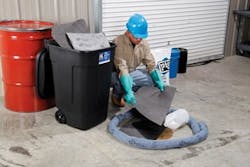Federal regulations ranging from the laboratory safety rules of the Occupational Safety and Health Administration (OSHA) to stormwater mandates of the Environmental Protection Agency (EPA) require facilities to have written plans for spill prevention and clean-up procedures.
Proper response plans are clearly written and comprehensive enough to cover any scenario that may occur at a facility. They should enable all people in the organization to know and understand their roles and should serve as a resource for responders to safely and effectively perform their duties.
Regardless of whether a regulation gives general planning requirements or outlines specific elements, verifying that five crucial elements — scope of response, evacuation procedures, contact lists, response procedures, and resources needed —are adequately addressed and that plans are kept up-to-date and communicated through training and drills will help ensure safety and compliance.
SCOPE OF RESPONSE
Plans should document when employees are to clean up a spill as well as when they should evacuate and leave the response to people with more experience or training.
If employees will respond to certain spills, clearly differentiate between "incidental spills" they should be able to handle themselves and ones that may require evacuation and an "emergency response." Which spills fall into each category will depend upon the types of hazards posed, the level of training employees have and other factors.
Response plans must specify what actions various employees must take. Some employees may be trained to the technician level under OSHA's Hazardous Waste Operations and Emergency Response Standard (29 CFR 1910.120) and drill regularly to know how to clean up any spill that might occur on site; others may be trained to shut down their operations, activate an alarm and evacuate at the first sight of a leak. Plans should provide specific instructions on employees' roles.
Communicate spill response roles during training sessions and schedule regular drills to help reinforce roles and verify all employees are comfortable performing their given tasks.
EVACUATION PROCEDURES
Because life safety is the top priority in any type of emergency, every employee must know how to get to a safe location. Evacuation is a critical planning element, no matter the level of spill response training an employee has.
Even if a facility retains an outside contractor to respond to every spill that may occur and employees won't take any action to contain or clean up a spill, a number of OSHA standards still make evacuation procedures a required planning element.
In addition to mapping exit routes, plans should cover where employees are to re-group and to whom they should report so the facility can check that everyone has safely evacuated.
CONTACT LISTS
Such lists quickly can become outdated as employees relocate, change positions or retire, and new staff gets hired. In addition, local emergency management coordinators, fire chiefs, county supervisors and other government officials sometimes only hold their offices for relatively short periods.
Maintaining contact information can seem like a never-ending task. Having a good working relationship without outside responders, such as the local fire department and hazmat team, and being on the community's local emergency planning committee are two good ways to stay informed about personnel and other changes in local, state and regional contacts.
Utilizing the information listed on the site's contact list during annual drills also can help identify any needed updating.
RESPONSE PROCEDURES
These detail the steps responders should take to identify, contain and clean up a spill. Plans often focus on responding to a "worst case" incident. However, spills of less than 20 gallons (Figure 1) account for the highest volume of calls to the National Response Center. So, the steps outlined in the plan should be flexible enough to apply to smaller spills.
Employees who will perform the tasks listed in the response procedures should receive appropriate training on their duties and responsibilities.
To help staff that may need to interact with community responders during a large incident, consider incorporating national incident management system (NIMS) concepts into facility response plans and procedures. NIMS (see: www.fema.gov/national-incident-management-system) is a comprehensive, flexible system applicable to any incident that provides a common language and framework to allow all types of responders to interact and coordinate response efforts.
Local, state and federal emergency response agencies all are trained to manage incidents using NIMS; so employees who are familiar with it and understand its terminology and roles will be able to more effectively assist outside responders.
RESOURCES NEEDED
Having the appropriate tools, supplies and equipment to respond to spills is just as important as training and other response planning elements. Like maintaining contact lists, keeping an up-to-date and accurate list of spill-response resources takes a dedicated effort.
Because spills vary greatly, each facility must determine the response equipment and supplies appropriate for its operations.
An up-to-date list of response materials aids in regulatory compliance and can serve as a checklist during periodic audits or inspections to help ensure all resources still are available and ready for use. After an incident, the list also can help determine what materials need to be restocked.
When spill response requires larger, more expensive equipment, for example, containment booms, consider working with other facilities or response agencies in the area to share the cost of the equipment.
Many local and regional response agencies have established mutual aid agreements to share specialty response equipment and resources during large incidents. Although it's harder to verify if off-site equipment is available and in working order, knowing what resources are obtainable in the county or region can help reassure onsite responders that such equipment can be provided when necessary.
KAREN HAMEL is a technical writer for New Pig Corp., Tipton, Pa. E-mail her at [email protected].

